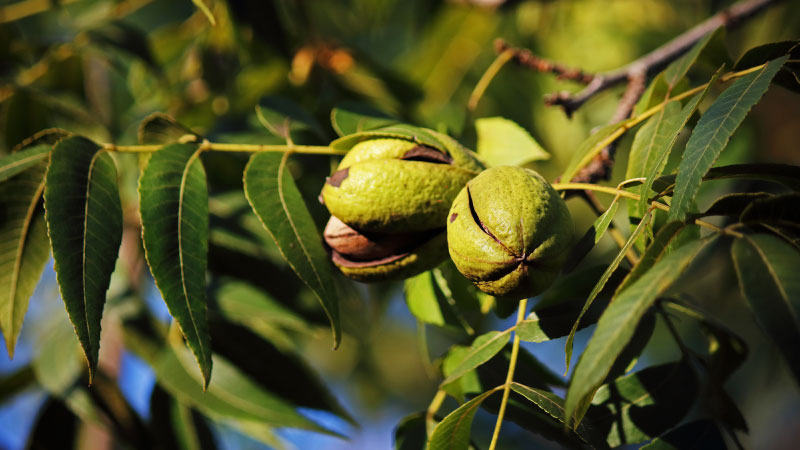Insect Invaders: Perils of Global Trade
As Japan rebuilt its economy in the decades following World War II, it shipped goods to U.S. consumers who loved the low prices. In more recent decades, China has taken Japan’s role as the low-cost shipper to the U.S. The way Hannah Burrack sees it, it just makes sense we have all these invasive pests from Asia.
“We get our bugs from where we get our stuff, and if we continue to do that, we will continue to get greater numbers of pests,” she says. “That’s basically the bottom line.”
Burrack, an Entomology Professor and Extension Specialist at North Carolina State University, is not alone in her assessment. On the other side of the country, Mark Hoddle notes it’s not just the shipments of goods that are bringing in pests. An Extension Specialist in Biological Control at the University of California, Riverside, he points out that 61 million people use the Los Angeles International Airport each year, with international flights to 58 countries.

Burrack
“We think it’s all boiling down to travel, especially tourism and trade,” he says. “There are lots of opportunities for those pests to come in.”
Though Hoddle, too, says he sees more pests coming in with cargo than on suitcases. Modern technology, one of the drivers of our global economy, is certainly having an effect.
“In the old days, ships would take three months to go halfway around the world — the pests might starve,” he says. “These boats are much faster and stop at more places; that’s why it’s happening.”

Hoddle
And make no mistake, it is happening. Hoddle says until 1989, six new arthropods entered the U.S. per year through California alone. That figure went up to an average of nine per year between 1990 and 2010, a 50% increase. According to the Entomological Society of America, invasive species are responsible for up to 50% of the crop losses in California, a state that produces half the nation’s fruit and nut crops.
As for the nation as a whole, the society estimates the U.S. is adding about 11 new exotic species each year, with about seven of those being important pests. Overall, it estimates that invasive species — including both insects and weeds — cost the U.S. more than $122 billion per year.
Four of these invasive insects from Asia have garnered a lot of attention, both because they are relatively new to the U.S., and because they have the potential to do a lot of destruction. We talked to entomologists around the country to gain better insight on these pests: spotted wing drosophila (SWD), brown marmorated stink bug (BMSB), Asian citrus psyllid (ACP), and the newest member, spotted lanternfly (SLF).
Brown Marmorated Stink Bug
BMSB (Halyomorpha halys) is perhaps the most familiar of the four because it is so pervasive. Since initially landing in Pennsylvania, it’s found in 44 states, “everywhere but the plains and deserts,” says Jim Walgenbach, a North Carolina State University Extension Entomologist who is Director of a USDA project, Management of BMSB on U.S. Specialty Crops.
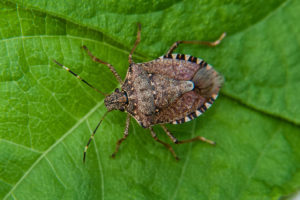
Brown marmorated stink bug is now found in pretty much every part of the U.S. that produces fruit. (Steve Schoof, NC State)
It’s an intensive national effort, with a team of more than 50 researchers from around the country. With the catchy website, StopBMSB.org, they have a national monitoring program to find where BMSB is established and where it’s expanding, as well as modeling populations to find the greatest risks to specialty crops.
Researchers have traps set in 300 locations, “from New York to Georgia, California to Washington, and almost everything in between,” Walgenbach says.
They intensify efforts wherever they are needed. Last year, for the first time, BMSB went after northern Utah tree fruits, and this year the big concern is California tree nuts. In fact, just recently, BMSB has been targeting almonds. In the near future, they plan to set additional traps in Michigan.
The pest has become ubiquitous in the Mid-Atlantic states. Another major area is Oregon, especially the Willamette Valley. Interestingly, the populations originally established in Pennsylvania and in Oregon were separate introductions, which they determined because of differing genotypes.
Researchers are now focused on a biological control program, which they believe is critical, Walgenbach says. It revolves around the samurai wasp, which attacks BMSB eggs. It’s a native of Asia, where it causes a high degree of mortality. In the U.S., it was first picked up in 2014 in Maryland.

Walgenbach
Since then, like BMSB, it is now in 10 states. This year a lot of project cooperators will be working together to release the wasp in different areas to get it established. Though because the pest is adventive, not native, it unfortunately can’t be transferred across state lines due to USDA Animal and Plant Health Inspection Service regulations.
“In North Carolina, we can’t even have it in the lab, not unless you have approved quarantine facilities,” he says.
Walgenbach says the parasite represents the greatest potential to reduce populations. Most of the natural enemies of our native stinkbugs are poorly adapted to BMSB and won’t be nearly as much help as the samurai wasp.
“We don’t expect it to wipe them out,” he says. “But instead of a serious large invasion, populations will be reduced and only occasionally reach pest status and require supplemental control.”
They also hope to reduce insecticide use a great deal because they’re still reliant on broad-spectrum pyrethroids, and those are disrupting a lot of biological control programs. But they can be effective, especially when used in conjunction with pheromone traps to lure the insects into a given area, setting up an attract-and-kill scenario.
Asian Citrus Psyllid
Asian Citrus Psyllid (ACP) has wreaked havoc on the Florida citrus industry, where it landed 20 years ago just north of the port of Miami. Hurricanes have since spread ACP throughout the state, along with the incurable disease it carries, Huanglongbing (HLB).
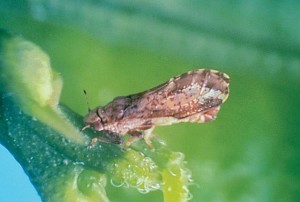
The Asian citrus psyllid is notorious for spreading HLB.
ACP spread to Texas in 2001 and arrived in California’s San Diego County in 2008. In the decade since, the $2 billion California citrus industry has spent millions to find ways to defeat the pest and limit HLB. For now, they are winning, but how long that will last is anyone’s guess.
The industry has been successful so far because it has been aggressive in going after ACP in the San Joaquin Valley, where most of the state’s commercial citrus groves are found. Another factor in their favor is ACP prefers the warm, uniform Southern California climate to the San Joaquin Valley (SJV), which is more extreme.
Hoddle, the specialist in biological control at UC Riverside, takes full advantage of the warmer, more moderate climate. He has made several trips to places like Pakistan in search of such parasitoids as Tamarixia radiata, a wasp.
Hoddle says he and his team just finished studying three years of data, and while ACP is continuing to spread, it’s been slowed in part because of biocontrols. They think the parasitic wasps have cut the population by 70% in Southern California backyards.
“We can’t say definitively it has led to the slower rate of the psyllid, but there are fewer of them around, so it stands to reason,” he says. “There still haven’t been any blow-ups in commercial citrus, and that’s the idea. We’re buying the growers’ time by fighting this battle in these urban areas.”
Spotted Wing Drosophila
SWD has become enemy No. 1 in many of the nation’s small fruits, including cherries and berries. But in some places the pest is more difficult to battle than others. In the arid West it is still very much a threat, but generally easier to deal with than in areas of the East and Midwest where rain can wash away pesticide sprays.

Rothwell
In Michigan, tart cherries represent an even bigger problem than sweet cherries, says Michigan State University’s Nikki Rothwell. With such tight margins, pesticide sprays are tough to afford. Rothwell, who serves as Coordinator of the Northwest Michigan Horticultural Research Center, says tart cherry growers have one thing going for them: SWD doesn’t get active until temperatures get warm.
“If growers can harvest before they hit, fine,” she says. “But if harvest goes long because of a big crop, we see SWD populations grow exponentially.”
One thing they have found is that the large tart cherry trees benefited from pruning to open the canopies. When they removed six to 10 limbs per tree, Rothwell said they reduced the larval infestation levels by 40%.
“They seem to like the dense canopy, lots of shade, high humidity, but still nice and warm,” she says. “Pressure was really heavy in those blocks with 15-year-old trees that hadn’t been pruned in years.”
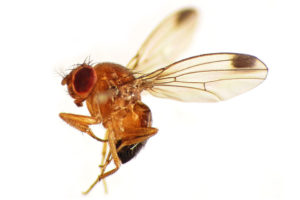
Though it was initially discovered in the U.S. in California, spotted wing drosophila has done more damage in other small fruit production regions. (Martin Cooper)
SWD is also firmly entrenched in the berry crops of the Southeast, says NC State’s Burrack. It arrived in the fall of 2010, and by 2011 was causing widespread crop losses.
“It’s been a complete game-changer,” she says.
The only variability is in winter temperatures. If it’s cold, populations develop later. But no matter what, they hit in early July. For strawberries and earlier blueberries, that year-to-year variability is meaningful for management, because anything that ripens after July is at risk. That includes 80% of the blackberries and 100% of the raspberries.
Insecticide applications are not enough during the second half of the growing season when populations are high, she says, so growers harvest as frequently as possible and as thoroughly as possible. It’s all about reducing the time the berry is susceptible to egg-laying SWD. For example, you don’t want to put a 6-day-old berry next to a 1-day-old berry, because all the low-risk fruit should be together.
“If you want workers to harvest cleanly, they have to pick bad fruit. So they use two buckets and you pay piece rate for both or an hourly wage,” she says. “Having a wayto harvest the fruit that doesn’t make it into a clamshell is important.”
It’s also critical to get the fruit cold quickly. Burrack is now looking into what temperature is needed for maximum mortality, but for now they know 40 degrees or less will keep an egg from developing.
“If growers do everything right: pesticide applications, harvesting as quickly as possible, and then chilling the fruit, only the eggs will be in there, no larvae,” she says. “Eggs get stopped in there and the fruit are salable.”
Spotted Lanternfly
Spotted Lanternfly (SLF) is by far the newest of the four to the U.S., having been discovered in 2014. Like BMSB, it was found in Pennsylvania.

Spichiger
Why both in Pennsylvania? One explanation put forth by Penn State Tree Fruit Research Entomologist David Biddinger is both were found somewhat near Philadelphia, the busiest port on the Eastern Seaboard.
Since then there have been detections in several nearby states, which doesn’t surprise Sven-Erik Spichiger, Pennsylvania Department of Agriculture Entomology Program Manager.
“It is such a good hitchhiker,” Spichiger says, echoing what others have said. “There’s a great possibility there are populations that haven’t been found.”
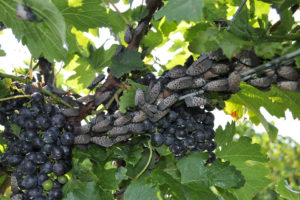
Grapes are a favorite fruit of spotted lanternfly. (Erica Smyers, Penn State)
SLF is unique. It is from a group of insects that are tropical and aren’t economic pests. Out of 900 fulgoroid species, also known as lanternflies — most closely related to leafhoppers in the U.S. — SLF is the only economic pest. No fulgoroids are found naturally in Pennsylvania.
A lot of early procedures to slow the spread of SLF were based on the pests’ invasion of Korea, where it became an economic pest of grapes and peaches. But not all the Korean literature has proven true for the U.S.
“(The Korean entomologists) said they would die from cold temperatures, but that’s obviously not true for our population,” says Biddinger. “Apparently the spotted lanternfly didn’t read that literature.”
Biddinger will continue to seek out a biocontrol for SLF and has begun looking into pesticides that might be effective.

Biddinger
“Biological control is always the most effective means in my opinion, but right now we have to put out brush fires, which means just finding a pesticide to kill them,” he says.
So far, their best guess in terms of pesticides is the neonicotinoid class because they can get into the sap.
“With every threatening new pest, we go back to spraying — you have to throw out your IPM program and start over again,” he says. “I’m a fifth-generation farm kid; I know farmers aren’t spraying for recreational purposes.” ●






